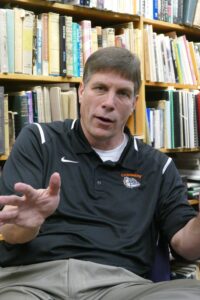Community rallies to support Cashmere’s struggling students
CASHMERE — The unspoken reality in school districts across North Central Washington is that a growing percentage of kids are not getting their basic human needs met — food, clothing, literacy skills and access to adult mentors – that are critical to their readiness to learn. Our schools have a growing number of kids dealing with toxic stress — such as the effects of violence, abuse, homelessness and divorce. Those traumas can overwhelm kids’ desire and ability to learn.
While these challenges are daunting, one school district in our region — Cashmere — is taking a bold approach to rally community support to address these needs and give all kids a better chance to succeed. Superintendent Glenn Johnson has created an initiative called “Cashmere Cares,” which rests upon four simple principles: No child hungry, no child cold, every child literate and every child a mentor.
Cashmere Cares has been slowly being developed for the last 18 months. Significant progress has been on making food and clothing available, thanks to a host of local businesses, services clubs, individuals and other organizations.
The Cashmere community has been enthusiastically responding to the Cashmere Cares program, Johnson told me. For example, Phil Blackburn of Martin’s Market is partnering with his food wholesalers to donate food. The district is also coordinating with the local food bank, various churches and other community groups. At the recent Cashmere Rotary Auction, $9,000 was raised to help fund Cashmere Cares efforts, Johnson said. The Cashmere School Foundation, a nonprofit, is handling the funds.
To support the district’s literacy program, volunteers have stepped forward to work with students to develop their reading skills. “It’s a win-win situation,” said Johnson. “Not only do the kids get reading aloud time, but they develop relationships with an adult,” he added.
The program is already showing tangible results. In 2014, 54 percent of kids entering first grade were fluent readers. Just one year later, 90 percent were fluent readers. The combination of volunteer efforts through Cashmere Cares, the district’s expansion of pre-school from 10 kids per year to 60 to help the most needy students, and the launch of an all-day Kindergarten all contributed to that success.
Mentorships have proven to be a bit more challenging to put into place, but progress is being made.
The issue of toxic stress and its impact on learning cannot be stressed enough. There is a tremendous amount of data nationwide that kids who have multiple adverse childhood experiences (death, divorce, violence, substance abuse, food insecurity, homelessness, etc) are highly likely to end up with unhappy life outcomes. These kids are so stressed and feel so unsafe that learning is extremely difficult. Trauma wires their brain to be continually in panic mode. This is where mentorships can be a vital link to help kids find hope, Johnson said.
If the district is going to bridge the achievement gap for kids, it’s going to first have to bridge the equity and opportunity gap that exists, he told me. The district, Johnson told me, is working to make sure that they identify kids who don’t have meaningful relationships and try to provide opportunities. The district is also talking with Confluence Health about the potential of a school-based healthcare office that can meet the physical and emotional needs of kids.
This is not about lowering standards for students who are disadvantaged, Johnson was quick to point out. High standards are critical. It’s about finding ways to reach all of the kids and expect them to meet those standards. “Lower standards will cripple them,” he said.
When Johnson gives his presentation at coffee shops, churches, service club luncheons and businesses, the immediate response is “how can we help.” That’s typical of Cashmere, which has earned a reputation for caring about kids. Cashmere Cares is simple, voluntary and relies upon the willingness of people to level the playing field for kids who are struggling by giving them meaningful support.
A version of this could be done in any district. Johnson said he’s willing to meet with anyone, anywhere about how a similar effort could be accomplished in another community.
The district is going to need even more support to fully engage the community. A community forum is going to be held early in 2017 to see where community members want to take this program. This is one of the most hopeful, powerful community programs I have seen.
For more information or to volunteer or donate, contact Johnson at gjohnson@cashmere.wednet.edu.

